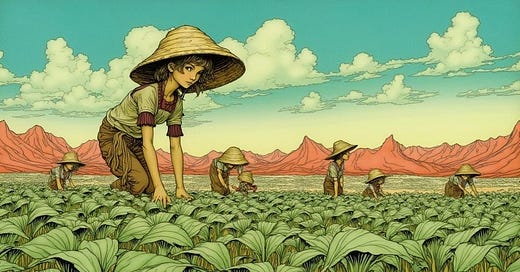Everyone had to work in the big fields; otherwise, everyone would starve. Safiya often ended up in the soybean fields. She would walk the rows, checking the soil with her toes and fingers, seeing if the dirt was too wet or too dry. The irrigation lines had to be carefully adjusted. Too much water and it was wasted; too little, and the plant struggled or died.
Soybeans were important. They made protein, fixed nitrogen in the soil, and kept the soil from blowing away.
“There’s water on Iphigenia,” Mister Kohn told them, “if you can get to it. But there’s almost no soil.”
Dirt in plenty. She came home red with it every day. But soil was more; soil was alive. It was granulate rock powder, sure, but decaying organic matter, worm and bug poop, bacteria, a galaxy of viruses, fungi, and nematodes. More decaying organic matter. Human poop, and lots of it: aged to make it safe, churned with powdered clays and bred soil microbes, spread on the fields.
“Iphigenia has plants, but not enough. They live on air, water, and what they can leach from the regolith. There’s hardly any soil. That’s what we have to make and save,” Mister Kohn said.
He gave them talks every day they went out, about soybeans, about roots, about Bradyrhizobium japonicum living in the root nodules, turning air into food for the beans. About little bugs that nibbled on the leaves.
“We want them,” he said. “We want an ecosystem. So, the bugs are good. But keep your eyes peeled. Too many, and they have to be controlled. Too few, and it will be out of balance.”
Safiya tolerated a few bean leaf beetles; one plant with aphids was okay. Too many bugs, and they went into her bug bag, picked off, or got sprayed with soapy water. Mister Kohn said there had been better ways to control these things back on Earth, but Iphigenia was poor, and resources were carefully balanced. They could make nanites to eat extra bugs, or they could use the tech to save the lives of sick people.
“You can grab a beetle,” he said when someone complained about handling little insects with their scrabbly legs. “You can’t make antibiotics with your fingers. Everybody ready? Let’s go to the kibbutz!”
He always called the soybean fields the kibbutz, and seemed to think it a fine joke, but he never explained. Some old Earth thing, some old Earth language, Safiya thought. Everyone had their little phrases that they said, their little in-joke among people whose skin or face or accent was alike, especially among the adults. The kids didn’t have many different accents in the new language and weren’t too curious about the old ones, and it was in them that the Town Council had its hopes. They had their own jokes and slang.
The older kids called it the komunda kampo de soyfabo, and the young ones, like Safiya’s brother, would say komkamso, and they all walked up and down the rows all day Starsday. They moved along in broad lines over the green, waving hectares, their straw hats wide, leaning over, feeling dirt, feeling leaves, looking at blooms, and later at little beans, their coveralls rolled up to the knees, sweat down their backs, and their feet in the soil. Real soil.
You could tell the difference by the smell. It had a wet, edible odor, warm and alive. If you broke it up, sometimes a moving creature would struggle out of it. Terran, usually, but sometimes anxious native things too, surprised to find themselves in such a strange place, maybe. The regolith outside the fields was almost barren, dust on sand on pebbles on rocks on stone, though here and there a terran weed had set up housekeeping. In patches, along low and sheltered places, or in high places catching the sun, a few native “trees” and “bushes” and “grasses” looked disapproving, Safiya thought. An old quiet neighborhood invaded by young upstarts.
Pick a beetle, check a drip line, brush soil over an exposed root with your toe. The wind blew, and the leaves flashed dark green, light green, dark green, light green. Down, down, down, down the rows, all Starsday long.





